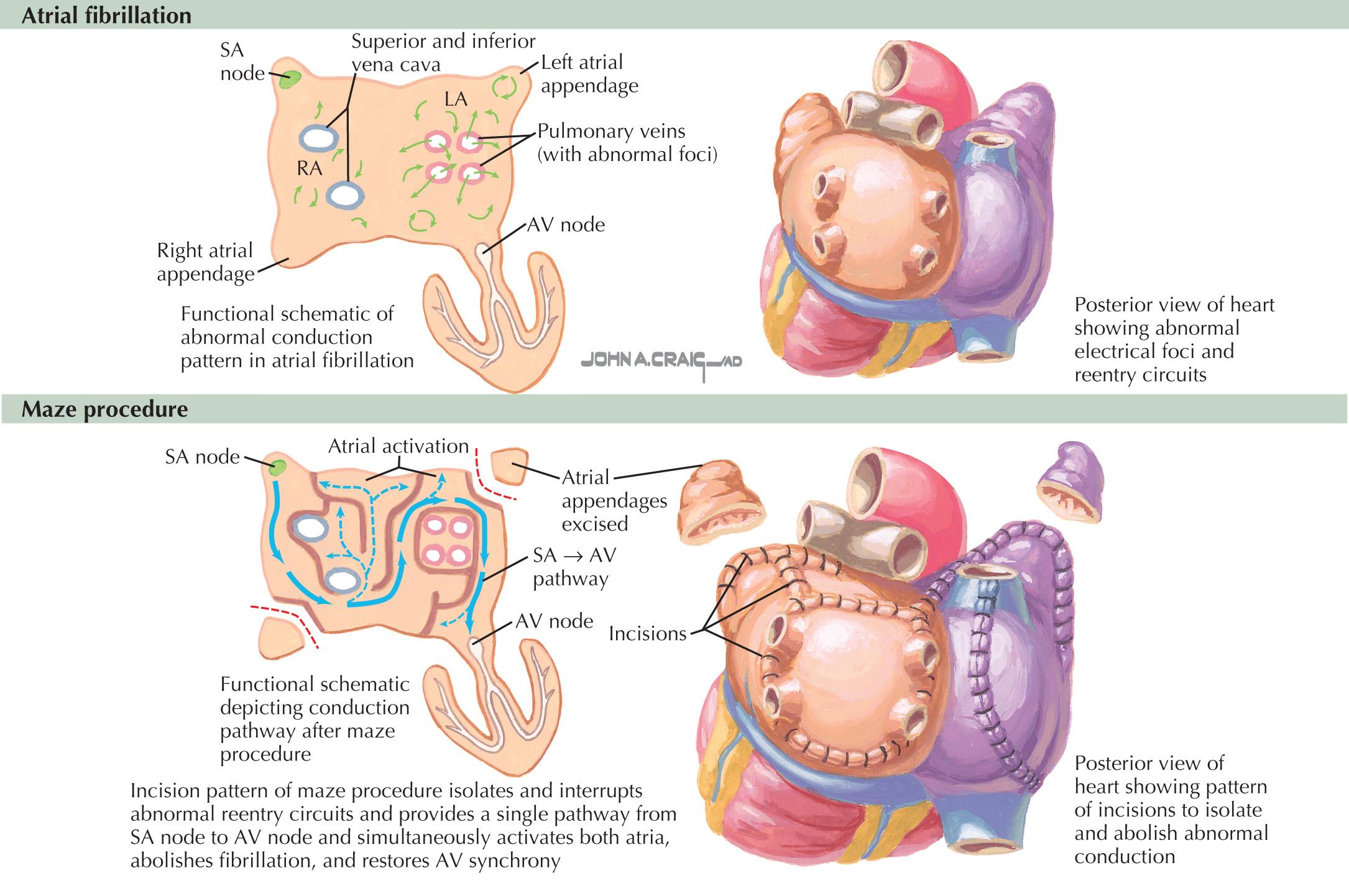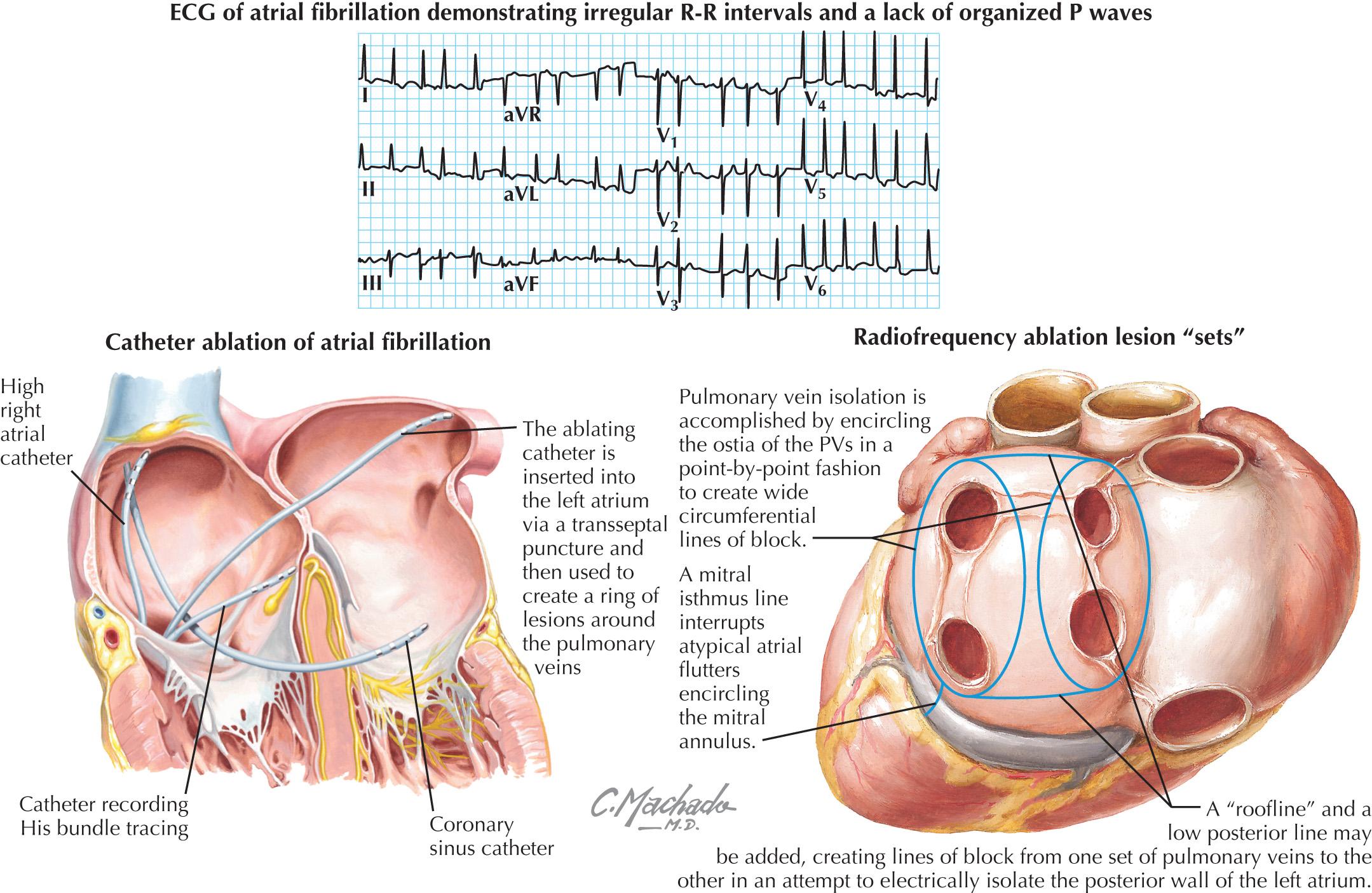Physical Address
304 North Cardinal St.
Dorchester Center, MA 02124
Although they were once considered investigational techniques, catheter and surgical ablation have evolved to become commonly performed procedures in major hospitals worldwide. Catheter ablation is the preferred therapy for typical atrial flutter, and it should be considered as a first-line therapy in select patients with atrial fibrillation (AF) when a rhythm control strategy is being pursued. A decision to pursue invasive management of atrial arrhythmias depends on a number of factors, including symptom burden, the type of arrhythmia, the presence of underlying cardiac structural abnormalities, the availability of noninvasive treatment alternatives, and patient preference. Current evidence is insufficient to demonstrate reduction of heart failure, stroke, or mortality after AF ablation, so the impetus to pursue ablation currently remains a reduction in symptoms and an improvement in quality of life. Symptomatic patients with paroxysmal AF have been best represented in clinical trials of catheter ablation and generally have the best chance of achieving a benefit from invasive therapies.
Ablation of AF is based on the concept that barriers to atrial conduction at critical locations would prevent maintenance of the abnormal rhythm ( Fig. 40.1 ). Using cut-and-sew techniques to create atrial barriers has been termed the Maze procedure. The Maze procedure has gone through multiple iterations. Newer techniques use bipolar radiofrequency or cryoablation as alternatives to the cut-and-sew technique. The Maze procedure has a high reported success rate. However, because of its invasiveness and complexity, the Maze operation has not been widely adopted except in patients with AF who are undergoing cardiac surgery for another reason, such as valvular disease.

Catheter ablation initially emulated the surgical Maze procedure by using radiofrequency ablation to produce linear lines of electrical isolation in the atrial endocardium. After the observation that focal tachycardia from the pulmonary veins often provokes AF, there has been increasing enthusiasm for treatment of AF through ablation of these triggers. Electrical isolation of the pulmonary veins and their left atrial orifices has become the cornerstone of any AF ablation procedure.
Catheter ablation can be performed under general anesthesia or conscious sedation. Femoral venous access is used to introduce catheters into the right-sided cardiac chambers. From there, transseptal needle puncture provides a route to the primary chamber of interest in AF ablation, which is the left atrium. The procedure may be preceded by transesophageal echocardiography to exclude the presence of left atrial appendage thrombus. During the procedure, intravenous heparin is administered to prevent thrombus formation. Details of the complex anatomy of the left atrium are often evaluated by preprocedural CT or MRI. Fluoroscopy and three-dimensional electroanatomic mapping systems are used to reconstruct left atrial anatomy and to track catheter movement during AF ablation.
The delivery of radiofrequency energy via transvenous electrode catheter achieves myocardial ablation by conducting alternating electrical current through the resistive medium of myocardial tissue. After several seconds at a temperature >50° C, myocardial tissue necrosis occurs, resulting in nonconducting scar tissue.
In general terms, the number and configuration of radiofrequency lesions delivered to the atria vary according to the type of AF (see definition of types of AF in Chapter 38 ). In paroxysmal AF, complete electrical isolation of the pulmonary veins from the left atrium is usually sufficient to achieve clinical success. Current approaches to pulmonary vein isolation involve a wide ring of encircling lesions around the openings of the pulmonary veins into the left atrium ( Fig. 40.2 ).

Compared with paroxysmal AF, the efficacy of pulmonary vein isolation in persistent AF has been more modest. For this reason, pulmonary vein isolation is sometimes combined with additional ablation in cases of persistent AF. Approaches vary, but may include (1) ablation at sites bearing complex fractionated atrial electrograms (CFAEs), (2) the application of additional atrial lesion lines, and/or (3) ablation of the ganglionated plexuses.
CFAEs are intracardiac atrial electrograms distinct from the normal electrical signals of atrial tissue. CFAEs may demonstrate fractionated and/or rapid signals. These are believed to represent areas of abnormal electrical conduction and possibly high-frequency “drivers” of persistent AF. CFAEs can be identified by visual assessment of intraatrial recordings or by automated computer analysis.
The creation of lines of lesions is an attempt to emulate the surgical Maze procedure. Originally intended to interrupt reentrant circuits in the atrium, other possible mechanisms by which linear ablation may improve AF ablation outcomes are the incidental elimination of CFAEs and/or autonomic ganglia along the course of the linear lesions. Lesion “sets” may include any combination of the following: a “roofline” between the two upper pulmonary veins, a mitral isthmus line from the left inferior pulmonary vein to the mitral annulus, linear lesions to isolate the other thoracic veins (namely, the coronary sinus and the superior vena cava) or the left atrial appendage, and a conventional cavotricuspid isthmus (CTI) line to eliminate typical atrial flutter.
The observation that changes in autonomic tone can be associated with the initiation of AF has led some operators to target autonomic ganglia during AF ablation. Vagal stimulation may lead to premature atrial depolarizations, changes in refractoriness of atrial myocardium, and the development of CFAEs. Ganglionated plexuses are part of the cardiac autonomic system and are located within epicardial fat pads. Destruction of ganglionated plexuses during endocardial catheter ablation is achieved by transmural radiofrequency heating.
The optimal technique for ablation of persistent AF remains elusive. Recent studies have called into question the benefit of these strategies of ancillary ablation beyond the pulmonary veins.
The use of cryothermal energy delivered via a balloon-based system to achieve pulmonary vein isolation as a substitute for radiofrequency pulmonary vein isolation has grown rapidly. A transvenous catheter is used to position a balloon sequentially in the antra of the pulmonary veins ( Fig. 40.3 ). Liquid nitrous oxide is then delivered under pressure to the balloon, where it changes to gas, resulting in local tissue cooling. Freezing and ice crystal formation within tissue around the circumference of the balloon leads to disruption of cell membranes, changes in cellular metabolism, electrical activity, and microvascular blood flow. These changes ultimately lead to cell death and formation of a nonconductive scar.

Become a Clinical Tree membership for Full access and enjoy Unlimited articles
If you are a member. Log in here